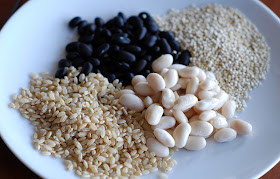I want to make it very clear here that I am not saying meat is a bad thing. In fact, there are times that my body cries out for meat and I happily indulge trusting that my body knows what it needs because I am doing my best to listen. This became very evident to me when I was pregnant and I practically crawled across the table to sink my teeth into my husband's [pasture raised, grass fed, organic] steak [not one of my more classy moments but I will fully exploit the pregnancy card on this one]. What I am saying is that our diet could use less meat and there are great alternatives that will provide the nutrients we need.
Legumes are one of these examples. Containing roughly 17 - 25 percent protein they can easily compete with meat in this category while also bringing calcium, potassium, iron, zinc, and several B vitamins as back up punches. And a bonus? They are low in fat! Combine these little guys with some whole grains and you have a complete essential amino acid profile meal.
And one more little tidbit about this pair [grains + legumes] - they are the only foods that boast all of the major nutrient groups: carbs, protein, fats [high-quality, healthy amount], vitamins, minerals, and fiber. Like I said, just a little thing.
So my challenge? Try swapping out one or two meat-full meals a week with a meat-free one. Start small and notice how you feel. If you are overcome with feelings of lightness, awareness, vitality, and energy after eating, know that it is your body's way of thanking you. Also pay attention to how you feel after you eat a meal [or a series of] with meat. If you feel sluggish, tired, and heavy your body is crying out for lighter fare.
 [AN IMPORTANT NOTE]
[AN IMPORTANT NOTE]I prefer to make my legumes [or dried beans] and grains from scratch which means these meals take a little bit of forethought because both whole grains and legumes are easier on your overall digestion if soaked. Think of it in terms of pulling the meat out of the freezer the night before. I choose the homemade route for a few reasons. First, I can control the sources [organic vs. not], what is added [chemical / preservative-free vs. not], and eliminate the tin or aluminum can [which has probably leeched chemicals into the beans]. Second, I prefer the taste. And third, I know that they have been soaked properly guaranteeing better digestion.
 [WHY SOAK?]
[WHY SOAK?]Phytic acid, a substance found in whole grains, blocks the absorption of iron, calcium, magnesium, copper and zinc [also known as the body's buddies] by combining with them and making them impermeable to the intestinal wall [in other words, making traitors out of them]. As if this isn't enough, enzyme inhibitors are also a part of this grainy deal [if you remember, enzymes work to break down food so the body doesn't have to do all the work meaning they are muy importante!]. Lucky for us, these little phytic and inhibiting bullies are easily disabled by sprouting, overnight soaking, and fermentation.
Despite what that old saying may say [you know the one, "beans, beans the musical fruit..."], "tooting" is not a great thing and in fact, may be a sign of intestinal irritation, poor digestion, and allergies [none of which feel good]. Soaking legumes helps to break down the sugars [oligosaccharides] making them more digestible and minimizes that not-so-nice aftermath.
[UM...A LITTLE "HOW" HELP?]
Soaking is really simple. Place your beans or grains in a non-reactive bowl [glass or enamel works well]. Cover with triple their volume in water because beans / grains could triple in size. Cover and soak 7 - 24 hours [see chart below]. Check beans / grains to see if they are fully hydrated. If not, re-cover and soak for a few additional hours, up to 24 hours. Once the soaking time is completed, drain and discard soaking water and rinse thoroughly at least twice.
Soaking will reduce cooking time requirements so check the beans from time to time while they cook.
Sprouting is an additional step you can take to make beans and grains even more digestible and increase protein content. You could also add 1 - 2 tablespoons of an acidic soaking medium [like lemon juice or apple cider vinegar] per cup of water to improve digestibility.
BEAN TYPE / SOAK TIME [IN HOURS]
Black Beans / 24
Black-eyed Peas / 12 - 24 *
Chickpeas / 24
Lentils / 7
Navy Beans / 12 - 24 *
Pinto Beans / 12 - 24 *
Red Kidney Beans / 12
Split Peas / 7
* smaller beans = more soak time
GRAIN TYPE / SOAK TIME [IN HOURS]
Amaranth / 24
Brown Rice / 7
Millet / 7
Oat Groats / 12 - 24
Quinoa / 12
Teff / 24



No comments:
Post a Comment